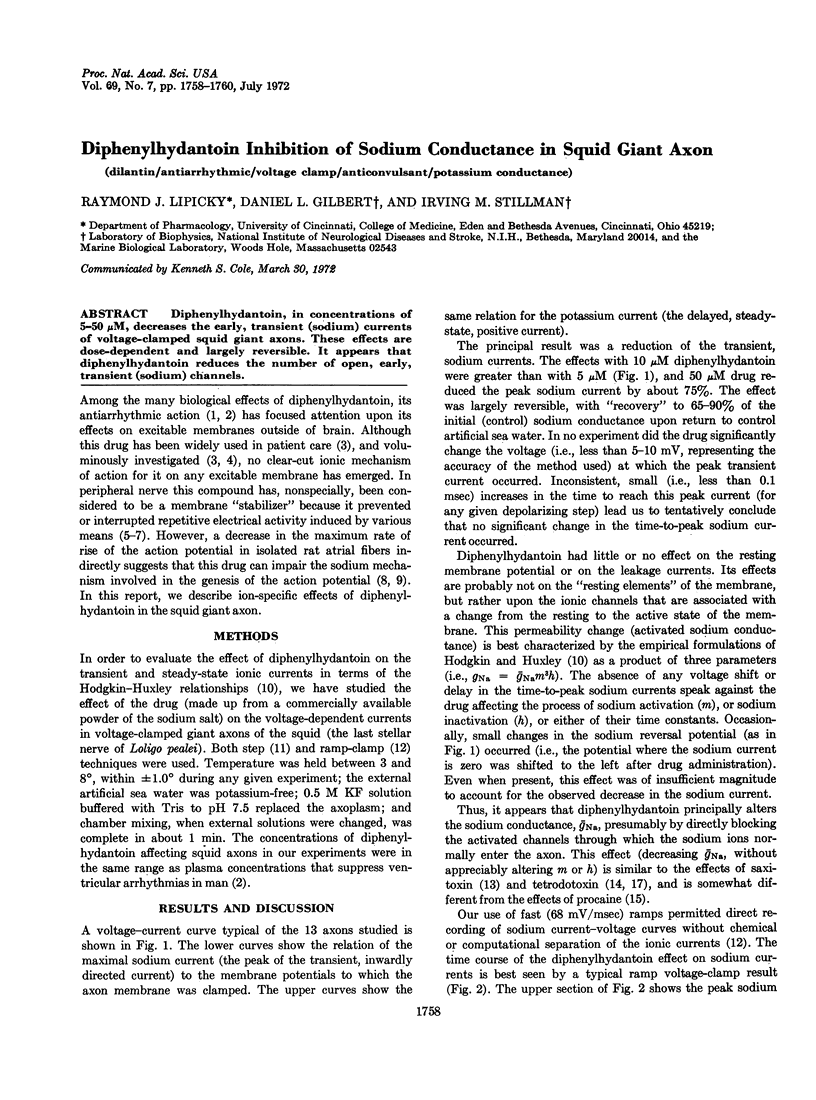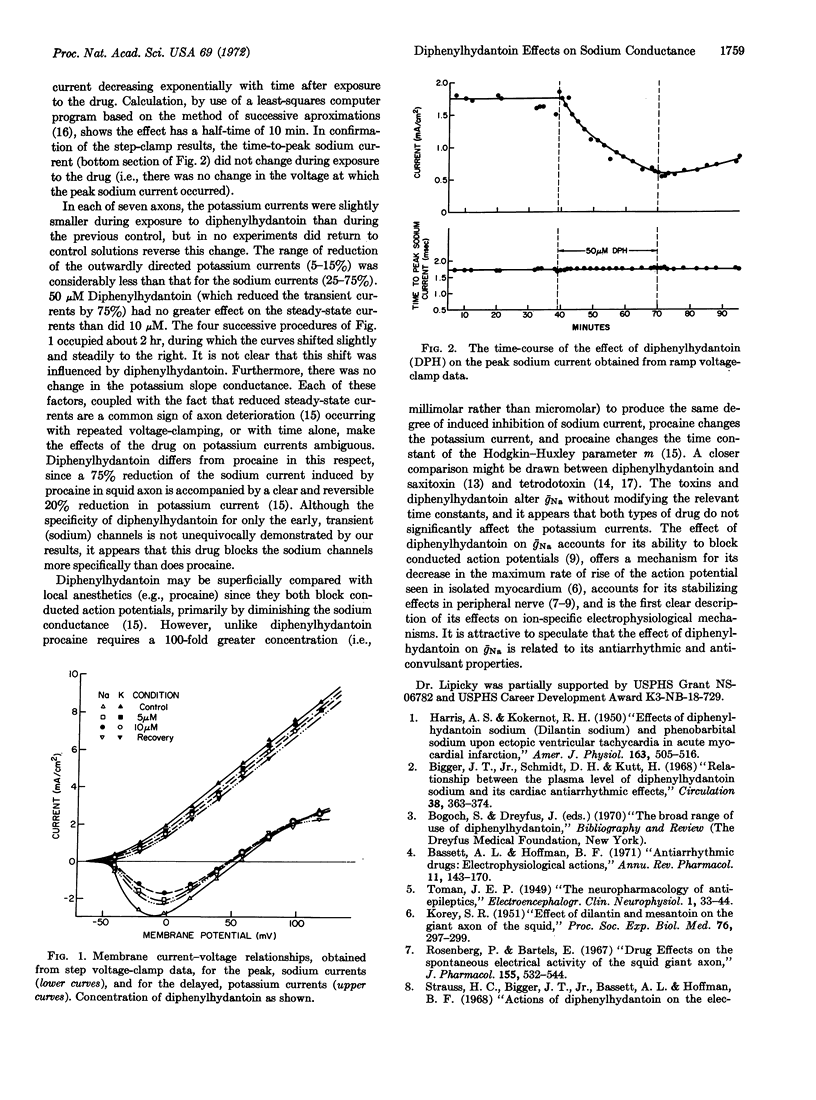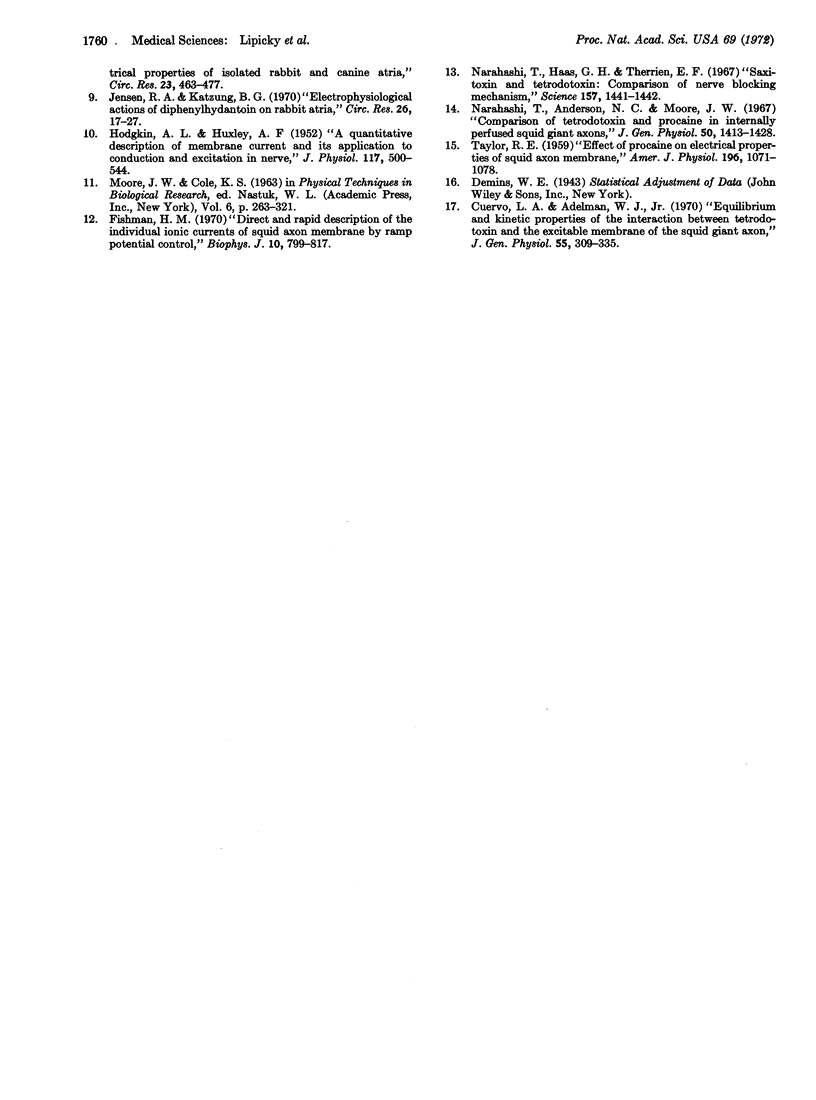Abstract
Diphenylhydantoin, in concentration of 5-50 μM, decreases the early, transient (sodium) currents of voltage-clamped squid giant axons. These effects are dose-dependent and largely reversible. It appears that diphenylhydantoin reduces the number of open, early, transient (sodium) channels.
Keywords: dilantin, antiarrhythmic, voltage clamp, anticonvulsant, potassium conductance
Full text
PDF


Selected References
These references are in PubMed. This may not be the complete list of references from this article.
- Bassett A. L., Hoffman B. F. Antiarrhythmic drugs: electrophysiological actions. Annu Rev Pharmacol. 1971;11:143–170. doi: 10.1146/annurev.pa.11.040171.001043. [DOI] [PubMed] [Google Scholar]
- Bigger J. T., Jr, Schmidt D. H., Kutt H. Relationship between the plasma level of diphenylhydantoin sodium and its cardiac antiarrhythmic effects. Circulation. 1968 Aug;38(2):363–374. doi: 10.1161/01.cir.38.2.363. [DOI] [PubMed] [Google Scholar]
- Cuervo L. A., Adelman W. J., Jr Equilibrium and kinetic properties of the interaction between tetrodotoxin and the excitable membrane of the squid giant axon. J Gen Physiol. 1970 Mar;55(3):309–335. doi: 10.1085/jgp.55.3.309. [DOI] [PMC free article] [PubMed] [Google Scholar]
- Fishman H. M. Direct and rapid description of the individual ionic currents of squid axon membrane by ramp potential control. Biophys J. 1970 Sep;10(9):799–817. doi: 10.1016/S0006-3495(70)86336-6. [DOI] [PMC free article] [PubMed] [Google Scholar]
- HARRIS A. S., KOKERNOT R. H. Effects of diphenylhydantoin sodium (dilantin sodium) and phenobarbital sodium upon ectopic ventricular tachycardia in acute myocardial infarction. Am J Physiol. 1950 Dec;163(3):505–516. doi: 10.1152/ajplegacy.1950.163.3.505. [DOI] [PubMed] [Google Scholar]
- HODGKIN A. L., HUXLEY A. F. A quantitative description of membrane current and its application to conduction and excitation in nerve. J Physiol. 1952 Aug;117(4):500–544. doi: 10.1113/jphysiol.1952.sp004764. [DOI] [PMC free article] [PubMed] [Google Scholar]
- Jensen R. A., Katzung B. G. Electrophysiological actions of diphenylhydantoin on rabbit atria. Dependence on stimulation frequency, potassium, and sodium. Circ Res. 1970 Jan;26(1):17–27. doi: 10.1161/01.res.26.1.17. [DOI] [PubMed] [Google Scholar]
- KOREY S. R. Effect of dilantin and mesantoin on the giant axon of the squid. Proc Soc Exp Biol Med. 1951 Feb;76(2):297–299. doi: 10.3181/00379727-76-18469. [DOI] [PubMed] [Google Scholar]
- Narahashi T., Anderson N. C., Moore J. W. Comparison of tetrodotoxin and procaine in internally perfused squid giant axons. J Gen Physiol. 1967 May;50(5):1413–1428. doi: 10.1085/jgp.50.5.1413. [DOI] [PMC free article] [PubMed] [Google Scholar]
- Narahashi T., Haas H. G., Therrien E. F. Saxitoxin and tetrodotoxin: comparison of nerve blocking mechanism. Science. 1967 Sep 22;157(3795):1441–1442. doi: 10.1126/science.157.3795.1441. [DOI] [PubMed] [Google Scholar]
- Rosenberg P., Bartels E. Drug effects on the spontaneous electrical activity of the squid giant axon. J Pharmacol Exp Ther. 1967 Mar;155(3):532–544. [PubMed] [Google Scholar]
- TAYLOR R. E. Effect of procaine on electrical properties of squid axon membrane. Am J Physiol. 1959 May;196(5):1071–1078. doi: 10.1152/ajplegacy.1959.196.5.1071. [DOI] [PubMed] [Google Scholar]
- TOMAN J. E. P. The neuropharmacology of antiepileptics. Electroencephalogr Clin Neurophysiol. 1949 Feb;1(1):33–44. [PubMed] [Google Scholar]


